Research Article
Inhibition Effect of Copper (II) Theophylline Nanocomplex on Phosphodiesterase (PDE) Enzyme Activity in Human Serum of Iraqi Patients with Asthma Disease
Zainab Sabri Abbas 1, Ahmad Hussein Ismail 2, Hassanain Kamil Al-Bairmani 2, Ahmed Mahdi Rheima 3,4 *, Ameer Radhi Sultan 5, Srwa Hashim Mohammed 6
1 Kut University College, Dentistry Department , Al-Kut, Wasit , Iraq, 52001.
2 Mustansiriyah University, College of Science, Department of Chemistry. Iraq.
3 Wasit University, College of Science, Department of Chemistry, Kut, Iraq.
4 College of technical engineering, The Islamic University, Najaf, Iraq
5 Department of Chemistry Lab, Al-lmamine Al-Kadhumain Medical City Hospital, Baghdad, Iraq.
6 Garmian University, College of Education, Department of Chemistry. Kalar, Iraq.
* Corresponding author: E-mail arahema@uowasit.edu.iq
Received: Aug. 3, 2020; Accepted: Aug. 5, 2021; Published: Nov. 2, 2021
Citation: Zainab Sabri Abbas, Ahmad Hussein Ismail, Hassanain Kamil Al-Bairmani, Ahmed Mahdi Rheima, Ameer Radhi Sultan, and Srwa Hashim Mohammed, Inhibition Effect of Copper (II) Theophylline Nanocomplex on Phosphodiesterase (PDE) Enzyme Activity in Human Serum of Iraqi Patients with Asthma Disease. Nano Biomed. Eng., 2021, 13(4): 364-371.
DOI: 10.5101/nbe.v13i4.p364-371.
Abstract
Copper (II) theophylline [Cu (THP)2(H2O)4] complex in nanoscale has synthesized by ultrasonic sonication method. This method was used in the development of smaller, dispersed, and unaggregated nanoparticles (NPs). The structure of nanocomplex was described and suggested by the molar conductance, Fourier transform infrared spectroscopy (FTIR), ultraviolet-visible spectroscopy (UV-Vis), solubility, atomic fire absorption, and C.H.N. elemental analysis as octahedral geometry. The size and morphology of nanocomplex measured by transmission electron microscopy (TEM) were 20 nm. The nanocomplex was studied on phosphodiesterase enzyme activity in human serum of Iraqi patient's asthma disease. The results showed a highly significant (p < 0.01) increase in the serum levels of phosphodiesterase enzyme activity in asthma patients (mean = 14.939 ± 3.021 ng/ml) compared with a control group (mean = 9.974 ± 2.032 ng/ml). The result also showed a highly significant (p < 0.01) decrease in the serum levels of phosphodiesterase activity in patients of asthma disease with theophylline (mean = 11.253 ± 2.479 ng/ml) compared to serum patients without nano and control groups. It is vital that the result showed a highly significant (p < 0.01) decrease in the serum levels of phosphodiesterase activity in patients of asthma disease with copper nano complex (mean = 9.563 ± 2.082 ng/ml) compared in patients of asthma disease with and without theophylline. As for comparing asthma disease with copper nano complex and control group, the result showed there was no significant effect (p > 0.05).
Keywords: Nanocomplex, Asthma, Phosphodiesterase (PDE), Theophylline, Ultrasonic sonication method
Introduction
Phosphodiesterase (PDE) is a hydrolytic enzyme that has been distributed in mammalian tissue worldwide and plays an essential role in the hydrolysis of cAMP and cGMP cell signals. PDEs can selectively control different cellular functions thanks to their versatility, enabling further distribution at the cellular and subcellular levels. These are new therapeutic targets of inflammation because of their essential role in intracellular signalling [1]. The nanocomplexes have characteristic physical, chemical, and biological applications, as studies have shown [2-12]. Nanotechnology has recently shown interest properties in the medical field through new constructions with practical feasibility [13-18]. Asthma is a chronic airway inflammatory condition in which many cells and cellular functions are involved: T lymphocytes, neutrophils, mast cells, eosinophils, macrophages, and epithelial cells in particular. This inflammation leads to episodes repeated, particularly at night or early morning, lead to airway lightness and the coughing of susceptible people. The incidents usually involve significant but unpredictable airflow barriers, often reversible or therapeutic spontaneously [19, 20]. The inflammation also raises the current bronchial hyperreactive to a variety of stimuli. In some patients with asthma, airflow restriction reversibility may not be complete. This resulted in significant increases in disease morbidity and mortality [21]. Early asthma concepts include airway obstruction that can be alleviated by medication and bronchial hyperresponsive (BHR) as the most significant symptoms characterizing asthma from other similar conditions, including chronic bronchitis and chronic obstructive pulmonary diseases (COPD) [22-24]. In recent times the concept of asthma has been strengthened by an understanding of the chronic inflammation of an airway submucosa of the asthmatic patients, which are the significant causes of asthma symptoms by traditional inflammatory infiltrators. Also, loss of airway blockage reversibility is known as a chronic inflammatory long-term consequence [25]. Also, a group of purine alkaloids is made up of methylxanthines. These are essential ingredients used in many plant species and foodstuffs, including tea, coffee beans, cocoa, and cola nuts [26-29]. Neonatal apnoea is produced by caffeine and theophylline (THP), bronchial and asthma treatment. Moreover, they are part of the drug mix for pain, cold, and cough daily [30]. Theophylline has been shown to induce bronchodilation through a chemical process, which contracts the smooth muscle. This results through inhibition of the PDE action, which breaks down circular nucleotides into the cell and increases cyclic monophosphate adenosine (cAMP) and cyclic monophosphate guanosine (cGMP) extracellular levels. This results in an extension of how the muscles are smooth [31]. Due to its bronchodilatory and anti-inflammatory effects, theophylline, a non-selective phosphodiesterase inhibitor, has been used for several years to treat asthma. However, it was gradually restricted because of a low therapeutic index and side effects [32]. The current study aims to develop asthma therapeutic by converting theophylline into an inorganic complex with copper ion in nanoscale, and It is clinically applied to patients with chronic asthma.
Experimental
Materials
Theophylline (C7H8N4O2) purty 99% , sodium hydroxide (NaOH) purty 98%, copper chloride (CuCl2) purty 99%, and dimethyl sulfoxide (C2H6OS) purty 97% were purchased from Sigma-Aldrich. Through the preliminary steps, de-ionized water was used.
Synthesis of copper (II) nanocomplex
medical nanocomplex of Cu(II) with theophylline (THP) as a ligand was synthesized using the ultrasonic sonication (20 KHz, Dispersed) method as depicted in Scheme (1). Accordingly, theophylline (0.004 mol) was dissolved in 40 mL fresh NaOH (0.004 mol) solution to prepare the medical ligand's sodium salt (0.1 M). The obtained solution was heated up to 70 °C, and then copper (II) chloride (0.002 mol in 40 mL) was added to an aqueous solution. The solution mixture was kept under ultrasonic sonication for 3 h at 70 °C. Subsequently, crystals of good quality emerged at room temperature and overnight incubation. Novel complexes isolated by filtration by filter paper then washed with de-ionized water and dried well in air. [16,33]. Complex [Cu(THP)2(H2O)4]: color: Greenish blue; Anal. Calc. for C14H18N8O6CuCl2: C, 34.04; H, 4.46 N, 22.69; Cu, 12.87. Found: C, 35.13; H, 4.22; N, 21.51; Mn, 12.02%.
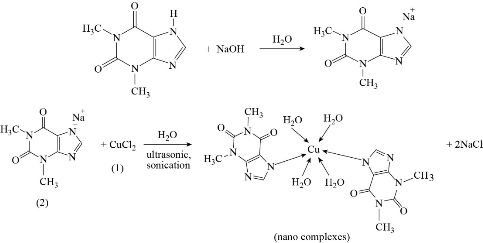
Scheme 1 Copper (II) nanocomplex synthesized at 70 °C.
Sample collection
Specimens collection
A total sample of 40 patients with chronic airway inflammatory (Asthma) was obtained from Allergy and Asthma center (Babylon). Who matched forty (40) standard control included in the present study was collected from various places. A 5 ml of venous blood samples have been taken from all the Patients and control by plastic disposable syringes and were allowed clotting at room temperature for 10 minutes from the patients and healthy controls then centrifuged at (3000x g) for 5 min. The serum samples have isolated and preserved at (-20 ᵒC) to study later [4].
Division of serum samples
Group one: Control group included no previous disease, which may interfere with the parameters analyzed in this study and preserved at (-20 ᵒC) to study later. This group had 40 Control. Group two: patients group included; chronic airway inflammatory (Asthma) and preserved at (-20 ᵒC) to later study. This group included 40 patients. Group three: patients group with nanomedicine complex [Cu (THP)2(H2O)4] were mixed 1:1, and preserved at (-20 ᵒC) to study later. This group included 40 patients. Group four: patients group with only theophylline were mixed 1:1. And it was preserved at (-20 ᵒC), to later study for comparison with group three. This group included 40 patients.
Determination of phosphodiesterases (PDE)
Phosphodiesterases (PDEs) are hydrolytic enzymes that destroy cyclic extracellular nucleotides. By changing the concentration of these second emissaries, PDEs control the cell and subcellular function. PDEs are distributed all around the human body in a compartmentalized way. The Phosphodiesterases (PDEs) were determined by the ELISA technique using the human ELISA Kit supplied from Melsin medical co. China. This kit includes a microtiter plate that is pre-coated with anticorps. Samples, HRP conjugated antibody to wells, and norm were introduced. Chromogen Solution A and B were added after gestation and cleaning to remove the unenhanced enzyme. The liquid's color will turn blue. The hue finally turns yellow at the influence of acid. The spectrophotometrical color change is measured at 450 nm wavelength. Phosphodiesterase concentration (PDE) in the samples is then compared with the O.D. The standard curve of the samples [34].
Characterisation
Copper nano complex was characterized via some devices. Transmission electron microscope (TEM) type JEOL JEM-2100 had used to determine the size and morphology of the copper nanocomplex. The U.V-Vis spectrum (Shimadzu UV-Vis 160 V ) helped us to predict the suggested geometry according to the shape and number of observed peaks. FT-IR spectra (Shimadzu FTIR) were used to define the coordination sits. ELISA technique was used to measure the Inhibition of Phosphodiesterase (PDE).
Statistical analysis
IBM USA SPSS software V-24 evaluated the data. The statistical carry out by one-way analysis of variance. The student t-test has been used to assess differences in mean values between the studied groups in all biochemical studies, where P˂0.01 was considered highly significant.
Results and Discussion
Copper (II) nanocomplex characterisation
The FTIR spectrum of theophylline (Fig. 1) showed an absorption band at (3120 cm-1), which referred to v (NH), which disappeared in the FTIR spectra of copper nano complex (Fig. 2). This indicated that the (NH) group was involved in coordinating theophylline with the copper ion. An additional broad absorption band could be seen in the region of 3560 - 3350 cm-1 for the prepared complex (hydroxyl group), representing the water stretching vibration, indicating water molecules' involvement in coordination. A new band in the complex appeared at 569 - 573 cm-1 referred to as metal coordination (N-M). Furthermore, all vibration bands in the nanocomplex shifted to a lower frequency than free theophylline due to hydrogen bonds of water molecules with the carbonyl and amine groups [35]. The electronic spectrum of [Cu (THP)2(H2O)4] complex (Fig.3) showed a broad absorption band at 678 nm (14749cm-1), which referred to 2Eg→2T2g transition, this band position is in good accord with the configuration of the octahedral. Therefore, we can suggest an octahedral structure around the Cu(II) ion from the above data and those obtained from elementary analysis (C.H.N.), FTIR, and flame atomic absorption. The transmission electron microscopy (TEM) measurement shows that the size of the particle is to be 20 nm. The sample was free from any aggregation, and the dimensions in the synthesized complex were within the nanoscale (less than 100 nm), which indicates that the type of nano is the particle and zero size, which is widely preferred in preparing nanoscales (Fig.4).
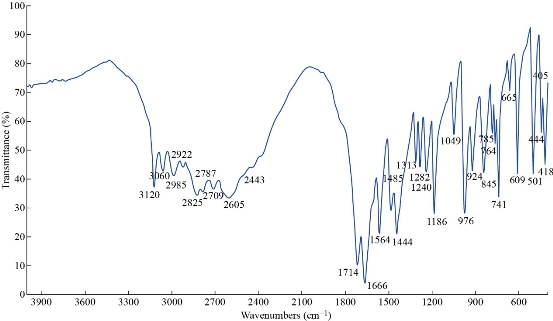
Fig. 1 FTIR spectrum of theophylline (THP).
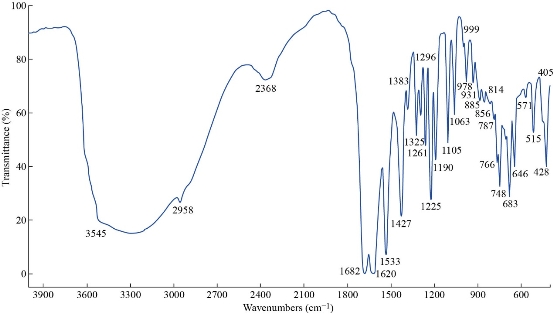
Fig. 2 FTIR spectrum of the [Cu (THP)2(H2O)4] nano complex.
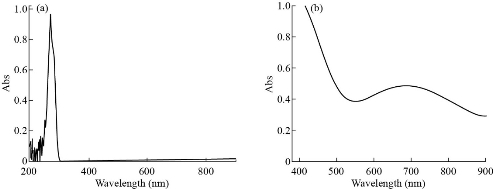
Fig. 3 (a) The UV-Vis spectra of [Cu (THP)2(H2O)4] complex at low concentration and (b) only visible spectra at high concentration.
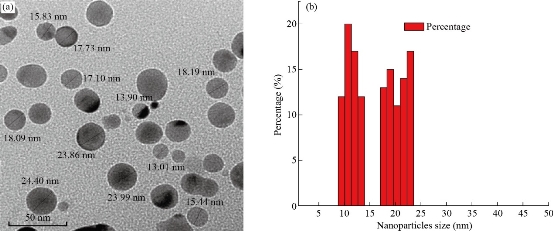
Fig. 4 (a) TEM of [Cu (THP)2(H2O)4] nano complex and (b) particle size distribution of Nano complex.
Effect of nanomedicine complex [Cu (THP)2(H2O)4] on phosphodiesterase (PDE) activity
Nano-biotechnologies are a 21st-century emerging field. In recent years, NPs have gained more considerable attention due to their unique and distinctive properties, intermediate to individual molecules and bulk matter. The use of copper compound NPs in gas sensors, hot transfer fluids, catalytic systems, solar energy, and batteries has been significant alongside other metal NPs [36-39]. Copper compound NPs can find various applications in agriculture, health care, and industry due to their antimicrobial activities. The growth, by opening many huddled doors in pathophysiology and therapy, of Nano-compounds has altered many medical concepts. In the pharmacological field, where the compound is antibacterial, antioxidants, anticancer, and so on, its apparent effects on an organism's biological molecules have not concealed, copper compounds in nanoscale play an essential role [40-47]. The more important thing is because the Surface Plasmon Resonance (SPR) of the copper nanoscale varies from other Nano compounds, which, due to interactivity between the conduction electrons of copper NPs and incident photon, represents a resonance effect. The interaction is based on copper NPs size and shape, and the scatter media's design and composition [48, 49]. One of the essential current diseases is asthma. This is one of the most prevalent inflammatory disorders in humans and impacts the people of all ages and cultural groups. Asthma has characterized by wheezing, tightness of the chest, and breathing difficulty [50]. The pathophysiological variation of asthma is triggered by several cell-specific interactions, which induce immunological response followed by airflow obstruction and, thus, by many inflammatory cytokines. An asthma diagnosis is based on the signs and symptoms of asthma. It is highly evident that these chronic and the most prevalent illnesses are detected and avoided early [51-53]. In asthma patients who kill cyclic extracellular nucleotides, PDE serum levels are increased, PDEs typically disrupt the phosphate groups, and cAMP or cGMP in target cells have decreased [54,55]. The effect of copper Nanocomplex on enzyme phosphodiesterase activity (PDE) in human serum patients with asthma disease had shown in the present study in Table 1 and Fig. 5. The results have shown a highly significant (p<0.01) increase in the serum levels of phosphodiesterase enzyme activity in asthma patients (mean = 14.939±3.021 ng\ml) compare with a control group (mean = 9.974 ± 2.032 ng/ml), The increase of PDE enzyme on the asthma patients have reported in many studies [56, 57]. The result also has shown a highly significant (p<0.01) decrease in the serum levels of phosphodiesterase activity in patients of asthma disease with theophylline (mean = 11.253 ± 2.479 ng\ml) compared to serum patients without nano and control groups. The vital thing in this study that has shown in the result a highly significant (p<0.01) decrease in the serum levels of phosphodiesterase activity in patients of asthma disease with copper nano complex (mean = 9.563 ± 2.082 ng/ml) compared in patients of asthma disease with and without theophylline. The clinical action of theophylline and theophylline nano complexes on phosphodiesterase enzyme of patients with asthma disease does cause bronchodilation through a chemical process that binds the smooth muscle. This results in an inhibition of the PDE action that separates cyclic nucleotides into the cells and increases extracellular levels of cyclic monophosphate adenosine (cAMP) and cyclic monophosphate guanosine (cGMP). This contributes to an expansion of the muscles' smoothness [58-62]. As for comparing asthma disease with copper nano complex and control group, the resulting has shown there was no significant effect (p > 0.05).
Table 1 Phosphodiesterase level in sera of controls and asthma patients
|
Groups |
Phosphodiesterase (ng/ml) Mean ± SD |
P-value |
|
Control patients (without treatment) |
9.974 ± 2.032 14.939 ± 3.021 |
< 0.01 |
|
Control Patients with treatment (theophylline) |
9.974 ± 2.032 11.253 ± 2.479 |
< 0.01 |
|
Control Patients with treatment (Nano complex) |
9.974 ± 2.032 9.563 ± 2.082 |
> 0.05 |
|
Patients without treatment Patients with treatment (theophylline) |
14.939 ± 3.021 11.253 ± 2.479 |
< 0.01 |
|
Patients without treatment Patients with treatment (Nano complex) |
14.939 ± 3.021 9.563 ± 2.082 |
< 0.01 |
|
Theophylline nano complex |
11.253 ± 2.479 9.563 ± 2.082 |
< 0.01 |
|
P < 0.01: Highly significant; p > 0.05: Non-significant |
||
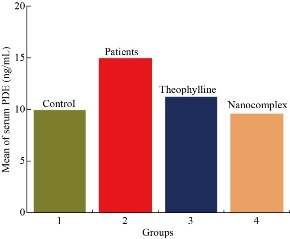
Fig. 5 Phosphodiesterase level in sera of controls and asthma patients.
Conclusions
The ultrasonic sonication method has used to synthesize complex in nanoscale. Our method has a display that the nanocomplex can easily be synthesized without aggregation. The size of NPs obtained in this study is 20 nm. The present work is the first study that explains the effect of copper nanocomplex on the activity of Phosphodiesterase (PDE) in 160 samples of sera for Iraqi patients with asthma diseases. The results have shown that the [Cu (THP)2(H2O)4] in nanoscale had an inhibition effect on the enzyme activity highly. The impact on the enzyme activity in Asthma patients shows that the nanomedicine complex [Cu (THP)2(H2O)4] has more inhibition effect than theophylline (p < 0.01).
Acknowledgments
This work was supported by the Chemistry Department, college of science, Mustansiriyah University.
Conflict of Interests
The authors declare that no competing interest exists.
References
Copyright© Zainab Sabri Abbas, Ahmad Hussein Ismail, Hassanain Kamil Al-Bairmani, Ahmed Mahdi Rheima, Ameer Radhi Sultan, and Srwa Hashim Mohammed. This is an open-access article distributed under the terms of the Creative Commons Attribution License, which permits unrestricted use, distribution, and reproduction in any medium, provided the original author and source are credited.